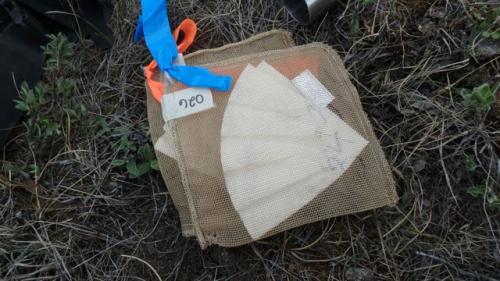Plants
I've had the good fortune to meet Rebecca Finger, a graduate student from Dartmouth College who is doing soil science research here. She is currently doing an observational study about plant-soil interactions. Like Christine, she is comparing/contrasting different conditions, so she has six sites at a distance from the ice, six at an intermediate distance, and six near the ice sheet. Unlike Christine, she is using three different plants. These are Salix glauca (gray or white or gray-leaf willow which is similar to Salix caprea or pussy willow in the U.S.), Betula nana (dwarf birch), and grasses. Again, since these are tundra plants, they are small, although the Salix can grow to five feet in height at a distance from the glacier where the air is warmer.
 Salix glauca - willow catkins (flowers).
Salix glauca - willow catkins (flowers).
 Betula nana (dwarf birch) - These leaves are .25-.5 inches.
Betula nana (dwarf birch) - These leaves are .25-.5 inches.
Soil and Decomposition
Soil cores taken at each site will be tested later in the lab to document the amounts of nitrogen and phosphorus (nutrients), soil density, and moisture content. The photo shows a very small soil core extracted at a warm weather site. It is so short because the soil below the active layer is frozen (permafrost).
 Soil core sample from a site distant from the glacier.
Soil core sample from a site distant from the glacier.
One means of differentiating the plants from one another is how they use nutrients from the soil. One of Rebecca's research tests involves placing litter packs under each of these plants at each research site.
Each litter pack consists of a heavy-duty plastic mesh pocket which contains a coffee filter; we sewed the packets shut with fishing line in our social tent back at camp. Then Rebecca labeled each packet with a number, a site reference, and a colored plastic strip for the years 2016 and 2017. Each packet was carefully weighed here in the lab. Then we buried each packet underneath one of the plants listed above. The leaf packs will be weighed once they are dug up, later this year or next year, in order to determine how much decomposition occurred. Some questions asked include:
- Will they decompose at different rates under different plants?
- Will they decompose at different rates at warmer and colder sites?
- What effect might the soil have on the characteristics of the leaves?
More below.
 Litter pack to be buried as a decomposition test.
Litter pack to be buried as a decomposition test.
Self-Defense
Another aspect of Rebecca's research has to do with how plants protect themselves from herbivores like the caribou and musk oxen who eat them. Plants can produce compounds in the leaves that make them distasteful to the herbivores. These compounds build up over time; young leaves are not as well protected as older leaves. Consequently, she also samples leaves from the plants at each of her sites. These will be tested next winter in the lab at Dartmouth.
Plants and Soil Work Together
Finally, the interaction between the plants and their soil can be addressed. Does the soil help the plants produce these compounds? If so, which nutrients are most necessary? Does the rate of decomposition relate to self-defense; that is, does rapid decomposition provide more nutrients for the plant to use to make its leaves unsavory to herbivores? Once again, I have found that science is fascinating! The questions that we ask, and the organisms that answer them are complex, beautiful, and endlessly interesting!
 Rebecca Finger getting ready to collect a soil core sample.
Rebecca Finger getting ready to collect a soil core sample.
Flag of the Day
 Honorable Mention Deborah Caitlyn's polar bear flag
Honorable Mention Deborah Caitlyn's polar bear flag
